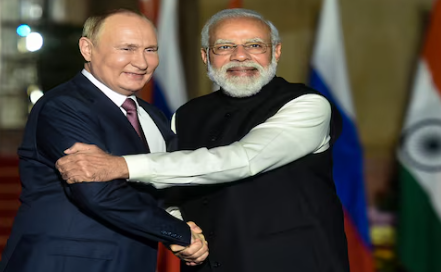What is Dynamic Reference Rate?
India and Russia are working on introducing a “dynamic reference rate” for their currencies, the Indian Rupee (INR) and the Russian Rouble (RUB), to make financial transactions between the two countries easier and to reduce the impact of U.S. sanctions on Russia. Despite these efforts, India’s Reserve Bank Governor, Shaktikanta Das, has clarified that there are no plans to completely stop using the U.S. dollar, which remains the dominant currency in global trade.
Current Financial Transaction Challenges
Currently, converting Indian Rupees to Russian Roubles is a complicated process. It usually involves first converting INR to U.S. dollars (USD) and then from USD to RUB. This process is made even more complex by U.S. sanctions, which limit Russian banks’ access to international financial systems, particularly for large transactions. Additionally, because India imports more from Russia than it exports, Russian banks end up holding large amounts of Indian Rupees, which complicates financial dealings further.
Proposed Solutions
To simplify this, India and Russia are considering setting up a direct exchange rate between the INR and RUB. This rate would be adjusted according to the market by both the Reserve Bank of India and the Bank of Russia. This plan is similar to a system India has with the UAE, where local currency settlements are used for transactions. Additionally, there is potential for Russia to invest its funds in Indian financial markets, which could strengthen economic ties between the two countries.
Continuation of US Sanctions
However, U.S. sanctions continue to restrict Russian banks’ access to global financial services, forcing them to rely on smaller banks for some transactions. This situation highlights the need for better systems for INR-RUB exchanges and investments, especially for large trade deals.
India’s Strategic Moves toward De-Dollarisation
Efforts to reduce dependence on the U.S. dollar were also discussed by Indian Prime Minister Narendra Modi and Russian President Vladimir Putin in July 2023. These discussions were part of a broader initiative within BRICS (Brazil, Russia, India, China, and South Africa) to lessen reliance on the dollar in international trade. India has also started a digital platform with ASEAN countries to conduct cross-border trade without using the dollar. Currently, about 60% of trade with Russia is done in local currencies.
The BRICS Initiative
BRICS countries are exploring the possibility of creating a new reserve currency backed by their collective currencies, although this has not yet been implemented. Projects like the BRICS Bridge are looking into using blockchain technology to enhance financial integration among member countries, especially through central bank digital currencies.
About Dynamic Reference Rate
The “Dynamic Reference Rate” (DRR) that India and Russia are considering would adjust according to real-time market conditions. It would serve as a benchmark for various financial products, such as loans and derivatives. Unlike fixed rates, the DRR is designed to increase transparency and reflect the rates set by central banks, which can help stabilize markets during volatile times. The use of DRR is growing, especially in emerging markets, as digital finance continues to advance.
Month: Current Affairs - August, 2024
Category: Economy & Banking Current Affairs



Dr.Cajetan Coelho
August 19, 2024 at 3:24 pmWorldmaking is a meaningful project. Dynamic Reference Rate is the need of the hour worldwide.
Tarh Aya
October 26, 2024 at 11:41 pmI like it